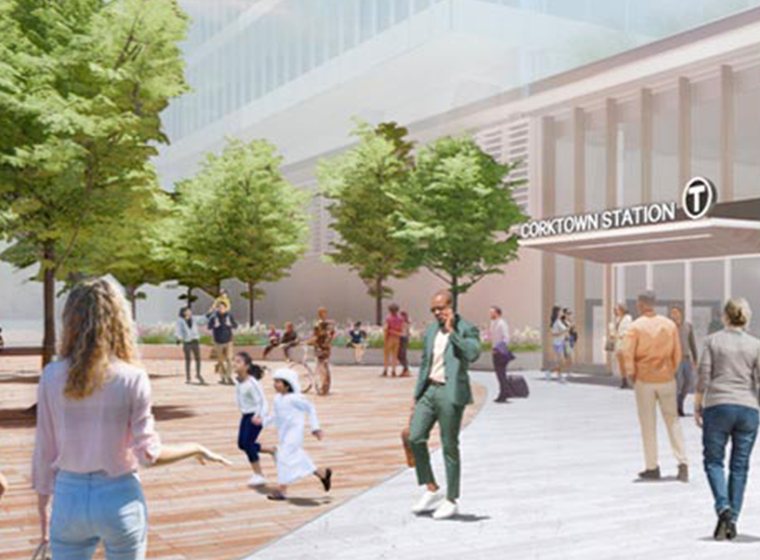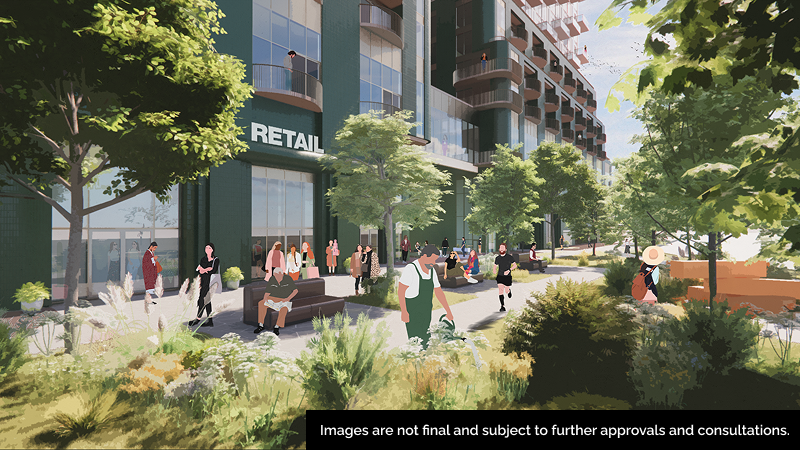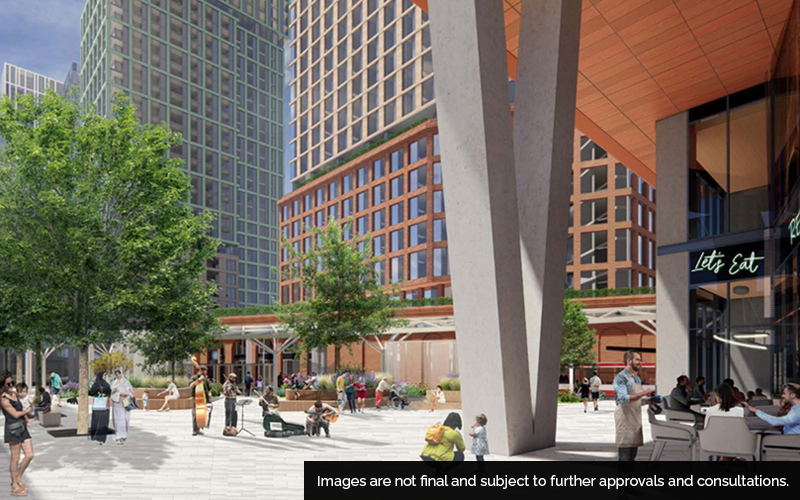Building communities around transit
Ontario is taking a bold, new and innovative approach to city building. The province is bringing faster, more reliable and seamless transit to the Greater Golden Horseshoe by expanding the GO transit network and delivering 4 new priority subway projects including the Ontario Line, the Yonge North Subway Extension, the Scarborough Subway Extension and the Eglinton Crosstown West Extension — the largest subway expansion in Canadian history.
Transit-Oriented Communities Program
The Transit-Oriented Communities Program will build vibrant, mixed-use communities that will bring more housing, jobs, retail, public amenities and entertainment within a short distance of transit stations. These transit-oriented communities and other transit development opportunities, will be located along the province’s 4 priority subway projects, GO Transit and Light Rail Transit (LRT) projects.
The Transit-Oriented Communities Program will:
- increase transit ridership and reduce traffic congestion
- increase housing supply (including affordable housing) and jobs
- stimulate the economy through major projects
- bring retail and community amenities (for example, community centres) within a short distance of transit stations
- offset the cost of station construction, saving taxpayers money
The benefits of transit-oriented communities are determined on a site-by-site basis and are subject to negotiations and with input from the local municipality, the public and Indigenous partners.
Proposed transit-oriented communities along GO and LRT networks
We’re proposing transit-oriented communities along GO and LRT networks, including:
Lakeshore East Line
Guildwood GO
The proposed transit-oriented community located at the Guildwood GO station would:
- connect transit riders to GO Transit, VIA Rail and TTC bus service
- deliver approximately 2,500 new homes
- support approximately 85 new jobs
- include a new park and open spaces
Lakeshore West Line
Clarkson GO
The proposed transit-oriented community located at the Clarkson GO station would:
- connect transit riders to GO Transit and local transit services
- deliver approximately 2,400 new homes
- support approximately 40 new jobs
- include open spaces
Oakville GO
The proposed transit-oriented community located at the Oakville GO station would:
- connect transit riders to GO Transit, VIA Rail and local transit services
- deliver approximately 6,880 new homes
- support approximately 400 new jobs
- include new roads, bike paths, a day care, community and green spaces
Milton Line
Cooksville GO
The proposed transit-oriented community located at the Cooksville GO station would:
- connect transit riders to GO Transit and the future Hazel McCallion LRT
- deliver approximately 3,000 new homes
- support approximately 550 jobs
- include a retail plaza, pedestrian-friendly public space, bike lanes and multi-use paths at street level
Stouffville Line
Milliken GO
The proposed transit-oriented community located approximately 500 metres from the Milliken GO Station would:
- connect transit riders to GO Transit, local YRT and TTC bus service
- deliver approximately 5,500 new homes
- support approximately 250 jobs in new commercial and retail spaces
- create approximately 5 acres of new public park space
Proposed transit-oriented communities along subway lines
We’re proposing transit-oriented communities along subway lines, including:
The map below shows proposed transit-oriented communities around subway stations and the Eastern Avenue transit hub.

Ontario Line
Corktown
The proposed transit-oriented community at the future Corktown Station would:
- commemorate the site's layered history including Indigenous heritage, the former Lake Ontario shoreline and Canada’s First and Second Parliament buildings — through a public park and new institutional space to support the community, for example, library and community space
- connect local bus, streetcar and subway service on the future Ontario Line
- deliver approximately 2,410 new homes, including affordable homes
- support approximately 350 jobs in new commercial, retail and community spaces
Cosburn
The proposed transit-oriented community at the future Cosburn Station on the Ontario Line would:
- deliver approximately 410 new homes
- support more than 35 new jobs in the new retail at street level
It will also include significant improvements to the streetscape and public spaces, including enhanced sidewalk zones with new landscaping and street furniture to create spaces for people to take a break and gather along Pape Avenue.
East Harbour
The proposed transit-oriented community at the 29-acre East Harbour site would include:
- approximately 4,000 new homes, including affordable homes
- the creation of a major employment centre expected to support more than 50,000 jobs in the area
- community amenities surrounding a transit hub — connecting GO Train, Ontario Line subway and streetcar services
Eastern Avenue
The proposed Eastern Avenue transit-oriented community, located near the future East Harbour Transit Hub would:
- deliver approximately 160 new homes
- support employment opportunities
- provide convenient pedestrian and cyclist access to the future East Harbour Transit Hub
- connect to GO Trains, SmartTrack, the Ontario Line subway and future TTC Light Rail Transit
Exhibition
The proposed transit-oriented community will transform Exhibition Station into a connected transit hub. It would:
- deliver approximately 1,450 new homes, including affordable homes
- support approximately 200 jobs in new commercial and retail spaces
- connect to GO Transit, TTC services, including the future Ontario Line subway
Gerrard-Carlaw North
The transit-oriented community at the future Gerrard Station on the future Ontario Line will:
- deliver approximately 1,080 new homes
- support approximately 225 jobs through new retail and other amenities
- create approximately 2 acres of public space, including a new public park almost 1 acre in size
- connect transit users to local TTC bus, streetcar and subway services
Gerrard-Carlaw South
The proposed Gerrard-Carlaw South transit-oriented community, located at the south side of the future Gerrard Station would:
- deliver approximately 1,315 new homes
- support approximately 460 jobs in new office, retail and general commercial space
- connect to the new Ontario Line subway and existing TTC streetcar and bus services
King-Bathurst
The proposed transit-oriented community at the future King-Bathurst Station would support the local neighbourhood while also maintaining the heritage component of this site, including the brick façade that was in place at this site prior to demolition. It would:
- deliver approximately 420 new homes
- connect to TTC streetcar service and the future Ontario Line service
Pape
The proposed transit-oriented community at the future Pape Station would:
- include new retail and office space
- deliver approximately 440 new homes
- support approximately 50 jobs
Residents and community members would benefit from direct, convenient and accessible connections to the new Ontario Line subway, the existing Bloor-Danforth subway and TTC bus services.
Queen-Spadina
The proposed transit-oriented community at the future Queen-Spadina Station would support a vibrant community, while taking into consideration the heritage components of the site. It would:
- deliver approximately 215 new homes
- support approximately 60 jobs in new retail space for businesses
- give transit riders convenient access to public transportation, including the TTC streetcar and the future Ontario Line subway
The proposed transit-oriented community at the future Thorncliffe Park Station would:
- deliver up to 2,660 new homes
- support approximately 980 new jobs in the increased retail and commercial space
The community would also include enhanced public spaces and a transit plaza, providing easy access to the Ontario Line subway.
Yonge North Subway Extension
Bridge
Once complete, the transit-oriented community at Bridge Station on the future Yonge North Subway Extension will:
- deliver approximately 20,800 new homes, including affordable homes
- support approximately 10,900 jobs in the new commercial, retail and community spaces
High Tech
Once complete, the transit-oriented community at High Tech Station will be served by the future Yonge North Subway Extension service, GO regional service, VIVA Rapid Transit and the encompassing major highways. It will:
- deliver approximately 19,300 new homes, including affordable homes
- support approximately 11,000 jobs
- offer community and public spaces including parks and plazas
Scarborough Subway Extension
Lawrence East
The proposed transit-oriented community at Lawrence and McCowan Station, on the Scarborough Subway Extension would:
- deliver approximately 740 new homes
- support approximately 310 new jobs in the new retail and general commercial space
Residents and the surrounding community would also benefit from more greenspace and a new park. The transit station design will connect pedestrians to a transit plaza and offer a drop-off area and an underground parking facility for quick and easy access to the Lawrence and McCowan Station.
Partnerships and community engagement
Ontario is working with Infrastructure Ontario and Metrolinx to deliver transit-oriented communities at or near new subway stations, GO stations and Light Rail Transit (LRT) stops. The province provides oversight to Infrastructure Ontario and Metrolinx, the agency partners working to deliver these transit projects.
We’re leading a multibillion-dollar public transit expansion plan in the Greater Toronto Area (GTA) and beyond across the GO transit network. This includes the subway expansion plan that will support multi-purpose, vibrant communities through Ontario’s Transit-Oriented Communities Program.
Infrastructure Ontario is responsible for the development and delivery of the Transit-Oriented Communities Program, leading negotiations with private sector partners and supporting the province’s engagement with municipalities, the public and Indigenous communities.
Metrolinx is responsible for leading transit project planning and delivery for the four priority subways, the provincial LRT projects and the entire GO transit service network.
Infrastructure Ontario, Metrolinx and private partners have been and will continue to collaborate with all parties involved (province, builders, municipalities, and the local community), to deliver new, modern subways and transit-oriented communities at a lower cost to the taxpayer. The province has signed formal agreements with the City of Toronto and York Region that establish common principles and ensures collaboration to enable the expansion and modernization of the subway network across the GTA, including transit-oriented communities.
Learn more about the Ontario-Toronto Transit Partnership and the Ontario-York Region Transit Partnership.
Public consultation is an important part of the process. Learn about upcoming public consultations and share your feedback to help shape the future of transit in your community.






















